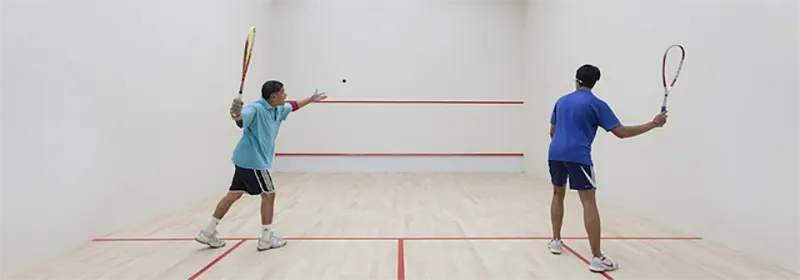16 August 2022 / 3-Min Read / Translate
Unless you are a spectator, seeing a foot fault in squash is not easy, neither as a player nor a ref. You have to make sure that the ball goes above, not ON or below the service line – that’s the one about head height across the front wall – AND watching the server’s feet is hard. Even professional referees often miss it.
In professional tennis, they have a line judge whose job is it to watch for foot faults and after the ball has been served, to say if the ball is in or out at the end of the court. Professional squash has one referee and maybe a video review referee, so it’s quite hard to do a perfect job.
Not much, but that’s not what is important. It’s part of the rules and those rules should be followed. If you begin to ignore those faults, where do you say which rule is important and which not? In the image below, the player could make contact with the ball in exactly the same palce, but have his left foot further back and it would be a valid serve. In this case the server hasn’t really gained any advantage, but again, that’s not what is important. A rule has been broken and a fault should be called.

You can clearly see that the both of the server’s feet are outside of the service box at the point of contact.
I really do think that it is very hard for a referee to be sure when a foot fault has been made. Watching the feet and then looking up to watch the ball hit the front wall is hard, especially if the ball hits close to the service line. My proposed solution is that the referee is allowed to call a “Potential Foot Fault” (PFF) . If the referee believes that the serve was a foot fault, but is not entirely sure, they can shout “STOP!” immediately after the serve has been hit and ask for the point to be replayed.
Each server could have a maximum number of these PFFs per game or match. Alternatively, the player is allowed 2 consecutive PFFs after which the point is awarded to their opponent. I have no doubt that might be unfair, especially when the rule is introduced, butt he solution is simple, easy and clear: servers just make sure they don’t even get close to a foot fault.
I don’t like my solution number 1. It’s just adding more rules and complexity, and I want less rules and more simplistically. It does address the issue for referees and matches that have referees, but for 95% of the rest of the matches around the world on any given day, it doesn’t help. That said, when have YOU called a foot fault in a friendly match? Probably never, but we are happy to say “Out” when we think the ball went out at any time.

I prefer my solution number 2. I propose we completely removed the service line. Not only would that allow referees the ability to focus on the feet at the moment of impact on a serve, it would also open up the possibility of new and interesting range of serves. While we are changing the rules, I would also remove the rule that says the serve must hit the front wall first. Let’s have some cool boast serves!